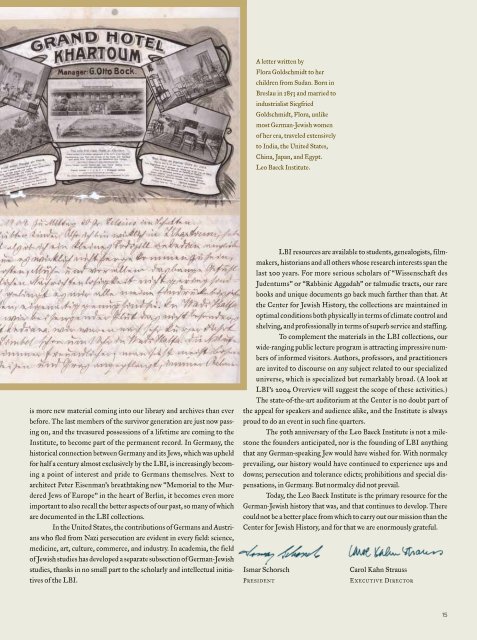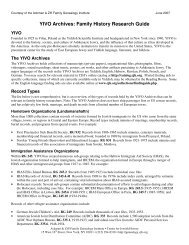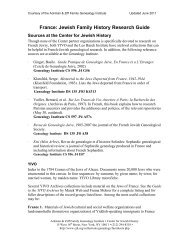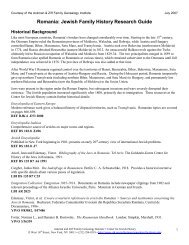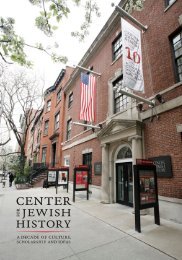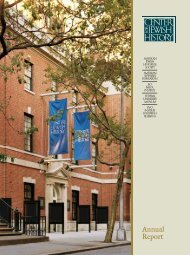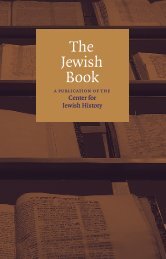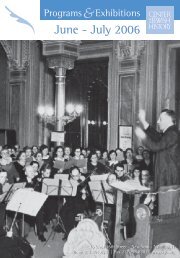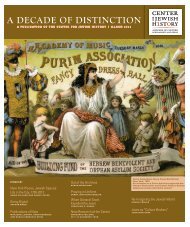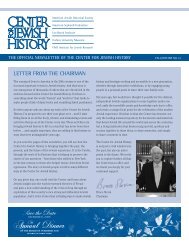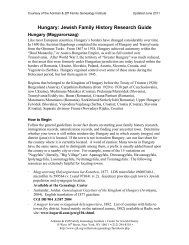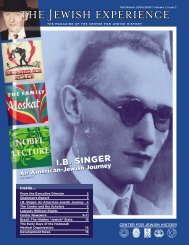Annual Report - Center for Jewish History
Annual Report - Center for Jewish History
Annual Report - Center for Jewish History
You also want an ePaper? Increase the reach of your titles
YUMPU automatically turns print PDFs into web optimized ePapers that Google loves.
A letter written byFlora Goldschmidt to herchildren from Sudan. Born inBreslau in 1853 and married toindustrialist SiegfriedGoldschmidt, Flora, unlikemost German-<strong>Jewish</strong> womenof her era, traveled extensivelyto India, the United States,China, Japan, and Egypt.Leo Baeck Institute.is more new material coming into our library and archives than everbe<strong>for</strong>e. The last members of the survivor generation are just now passingon, and the treasured possessions of a lifetime are coming to theInstitute, to become part of the permanent record. In Germany, thehistorical connection between Germany and its Jews, which was upheld<strong>for</strong> half a century almost exclusively by the LBI, is increasingly becominga point of interest and pride to Germans themselves. Next toarchitect Peter Eisenman’s breathtaking new “Memorial to the MurderedJews of Europe” in the heart of Berlin, it becomes even moreimportant to also recall the better aspects of our past, so many of whichare documented in the LBI collections.In the United States, the contributions of Germans and Austrianswho fled from Nazi persecution are evident in every field: science,medicine, art, culture, commerce, and industry. In academia, the fieldof <strong>Jewish</strong> studies has developed a separate subsection of German-<strong>Jewish</strong>studies, thanks in no small part to the scholarly and intellectual initiativesof the LBI.LBI resources are available to students, genealogists, filmmakers,historians and all others whose research interests span thelast 200 years. For more serious scholars of “Wissenschaft desJudentums” or “Rabbinic Aggadah” or talmudic tracts, our rarebooks and unique documents go back much farther than that. Atthe <strong>Center</strong> <strong>for</strong> <strong>Jewish</strong> <strong>History</strong>, the collections are maintained inoptimal conditions both physically in terms of climate control andshelving, and professionally in terms of superb service and staffing.To complement the materials in the LBI collections, ourwide-ranging public lecture program is attracting impressive numbersof in<strong>for</strong>med visitors. Authors, professors, and practitionersare invited to discourse on any subject related to our specializeduniverse, which is specialized but remarkably broad. (A look atLBI’s 2004 Overview will suggest the scope of these activities.)The state-of-the-art auditorium at the <strong>Center</strong> is no doubt part ofthe appeal <strong>for</strong> speakers and audience alike, and the Institute is alwaysproud to do an event in such fine quarters.The 50th anniversary of the Leo Baeck Institute is not a milestonethe founders anticipated, nor is the founding of LBI anythingthat any German-speaking Jew would have wished <strong>for</strong>. With normalcyprevailing, our history would have continued to experience ups anddowns; persecution and tolerance edicts; prohibitions and special dispensations,in Germany. But normalcy did not prevail.Today, the Leo Baeck Institute is the primary resource <strong>for</strong> theGerman-<strong>Jewish</strong> history that was, and that continues to develop. Therecould not be a better place from which to carry out our mission than the<strong>Center</strong> <strong>for</strong> <strong>Jewish</strong> <strong>History</strong>, and <strong>for</strong> that we are enormously grateful.Ismar SchorschPRESIDENTCarol Kahn StraussEXECUTIVE DIRECTOR15


